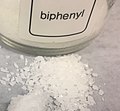Biphenyl
Biphenyl[edit]
Chemical structure of biphenyl Biphenyl is a chemical compound consisting of two benzene rings connected by a single bond. It is also known as diphenyl or phenylbenzene. The molecular formula of biphenyl is C12H10, and its molar mass is 154.21 g/mol. This aromatic hydrocarbon is widely used in various industries due to its unique properties.
Properties[edit]
Biphenyl is a colorless solid with a distinct pleasant odor. It has a melting point of 69.2 °C and a boiling point of 255.7 °C. The compound is insoluble in water but soluble in organic solvents such as ethanol and benzene. Biphenyl is nonpolar and exhibits low reactivity, making it relatively stable under normal conditions.
Production[edit]
Biphenyl can be synthesized through several methods. One common method is the Friedel-Crafts reaction, where benzene reacts with benzene chloride in the presence of a Lewis acid catalyst. Another method involves the dehydrogenation of 1,2-diphenylethane using a suitable oxidizing agent. Industrial production of biphenyl often involves the distillation of coal tar, which contains various aromatic compounds.
Uses[edit]
Biphenyl has numerous applications in different industries. One of its primary uses is as a heat transfer fluid in various heat exchange systems. Its low viscosity and high thermal stability make it an ideal choice for this purpose. Biphenyl is also used as a precursor in the production of polychlorinated biphenyls (PCBs), which were widely used as electrical insulators and coolants before their environmental hazards were discovered.
In addition, biphenyl finds applications in the production of dyes, pharmaceuticals, and fragrances. It is used as a starting material in the synthesis of various organic compounds. Biphenyl derivatives, such as biphenylcarboxylic acid, are utilized in the manufacturing of liquid crystals, which are essential components in electronic displays.
Safety and Environmental Concerns[edit]
Biphenyl is considered to be relatively low in toxicity. However, prolonged exposure to high concentrations of biphenyl vapor or dust may cause irritation to the respiratory system and eyes. It is important to handle and store biphenyl properly to prevent any potential health risks.
Due to the environmental persistence and bioaccumulation potential of biphenyl, its use has been restricted in many countries. The production and disposal of biphenyl and its derivatives should be carried out in accordance with local regulations to minimize environmental impact.
See Also[edit]
References[edit]
<references group="" responsive="1"></references>
-
Bifenyl structure
-
Biphenyl 3D van der Waals model
-
Biphenyl sample
Ad. Transform your life with W8MD's Budget GLP-1 injections from $75


W8MD offers a medical weight loss program to lose weight in Philadelphia. Our physician-supervised medical weight loss provides:
- Weight loss injections in NYC (generic and brand names):
- Zepbound / Mounjaro, Wegovy / Ozempic, Saxenda
- Most insurances accepted or discounted self-pay rates. We will obtain insurance prior authorizations if needed.
- Generic GLP1 weight loss injections from $75 for the starting dose.
- Also offer prescription weight loss medications including Phentermine, Qsymia, Diethylpropion, Contrave etc.
NYC weight loss doctor appointmentsNYC weight loss doctor appointments
Start your NYC weight loss journey today at our NYC medical weight loss and Philadelphia medical weight loss clinics.
- Call 718-946-5500 to lose weight in NYC or for medical weight loss in Philadelphia 215-676-2334.
- Tags:NYC medical weight loss, Philadelphia lose weight Zepbound NYC, Budget GLP1 weight loss injections, Wegovy Philadelphia, Wegovy NYC, Philadelphia medical weight loss, Brookly weight loss and Wegovy NYC
|
WikiMD's Wellness Encyclopedia |
| Let Food Be Thy Medicine Medicine Thy Food - Hippocrates |
Medical Disclaimer: WikiMD is not a substitute for professional medical advice. The information on WikiMD is provided as an information resource only, may be incorrect, outdated or misleading, and is not to be used or relied on for any diagnostic or treatment purposes. Please consult your health care provider before making any healthcare decisions or for guidance about a specific medical condition. WikiMD expressly disclaims responsibility, and shall have no liability, for any damages, loss, injury, or liability whatsoever suffered as a result of your reliance on the information contained in this site. By visiting this site you agree to the foregoing terms and conditions, which may from time to time be changed or supplemented by WikiMD. If you do not agree to the foregoing terms and conditions, you should not enter or use this site. See full disclaimer.
Credits:Most images are courtesy of Wikimedia commons, and templates, categories Wikipedia, licensed under CC BY SA or similar.
Translate this page: - East Asian
中文,
日本,
한국어,
South Asian
हिन्दी,
தமிழ்,
తెలుగు,
Urdu,
ಕನ್ನಡ,
Southeast Asian
Indonesian,
Vietnamese,
Thai,
မြန်မာဘာသာ,
বাংলা
European
español,
Deutsch,
français,
Greek,
português do Brasil,
polski,
română,
русский,
Nederlands,
norsk,
svenska,
suomi,
Italian
Middle Eastern & African
عربى,
Turkish,
Persian,
Hebrew,
Afrikaans,
isiZulu,
Kiswahili,
Other
Bulgarian,
Hungarian,
Czech,
Swedish,
മലയാളം,
मराठी,
ਪੰਜਾਬੀ,
ગુજરાતી,
Portuguese,
Ukrainian

